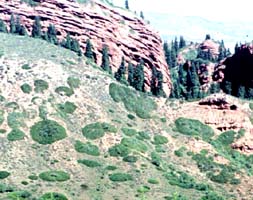
Stand in Jety-Ogyz, Kirgizstan [Vladimir Dinets] (5). |
Juniperus pseudosabina Fisch. & C.A. Mey. 1842
Common NamesVar. turkestanica is called Archa [Russian] (3).Taxonomic notesSyn: Sabina fischeri Antoine 1857; Sabina pseudosabina (Fisch. & C.A. Mey.) Cheng & Wang 1975; J. sabina Pall. 1776 non L. 1753; J. centrasiatica Komarov 1924; Sabina centrasiatica (Kom.) Cheng & Fu 1978; J. turkestanica Komarov 1924; Sabina pseudosabina var. turkestanica (Kom.) Yang 1978; J. pseudosabina var. turkestanica (Kom.) Silba 1984 (6).Recent studies using random amplification of polymorphic DNA show that taxa variously described as J. pseudosabina, J. centrasiatica and J. turkestanica form a continuum of variation, with variability between populations of comparable magnitude to variability between species. These results are supported by terpene analyses. Published morphological distinctions between the three taxa are either inconclusive, or incorrect as shown by observations of the taxa in their native range and by inspection of herbarium material (lectotypes). These lines of evidence also fail to support the variety J. pseudosabina var. turkestanica. In contrast, the same analysis supported segregation of Juniperus indica as a valid species (4). Description"A smaller erect shrub, similar to J. sabina in habit. FOLIAGE scale-like, 1-3 mm long and gray-green. FRUIT ovate, up to 12 mm long, black, with one seed" (2).It can also grow as a small tree (4). RangeData are a bit incomplete at this time, but it generally seems to occur throughout much of China: Xinjiang and neighboring areas including SE Kazakstan, Kirghizstan, Tadzhikstan and SW Mongolia, perhaps reaching into N Afghanistan or Pakistan (2, 3, 4). This range would include the Tian Shan and Altai, Pamir and Tarbagatay Mountains (2, 3). V. Dinets (3) adds: "[Var. turkestanica] and J. semiglobosa form extensive woodlands or even forests in some areas, from Transcaucasia to Xinjiang. They are logged to extinction for firewood in many areas, but under strict protection in others."Big TreeOldestDendrochronologyEthnobotanyObservationsRemarksCitations(1) Silba 1986.(2) Vidakovic 1991. (3) Vladimir Dinets, e-mail communications, 12 Jan 1998. (5) Vladimir Dinets, e-mail communication, 30-Jan-2000. (6) Farjon 1998. |
|
Juniperus | Cupressaceae | home
This page is from the Gymnosperm Database
|